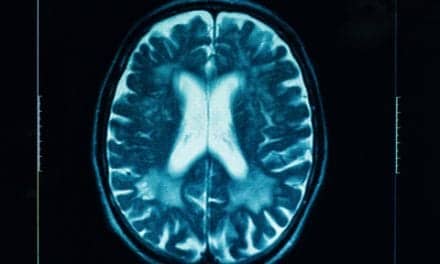
An 82-year-old female who suffered a left corona radiata CVA and presented with decreased left-sided neuromuscular control and coordination uses the body weight support device over the treadmill. The therapist assists with advancement and placement of her left lower extremity during functional ambulation.
By Devin Cooney, MOR, OTR/L; Brittany Merkh, PT, DPT; Kelly Tender, MS, CCC-SLP
According to the American Stroke Association, one in four people worldwide will have a stroke. It is the number five cause of death and a leading cause of long-term disability in the United States. More than 7 million stroke survivors are currently living in the United States.1
Many stroke survivors choose to go to an acute inpatient rehabilitation facility for their specific rehabilitation needs. In 2018, 1,494 individuals and their families selected Kessler Institute for Rehabilitation in Marlton, NJ, for their start of recovery. Thirty percent of those individuals were diagnosed with a stroke. Although their rehabilitation needs were different, they shared a common goal: to gain the skills, strengths, and strategies to rebuild their lives.
Recently, rehabilitation has shifted to include greater use of technology. The integration of technology-based rehabilitation within stroke recovery may empower an individual toward being more engaged in their own care in addition to forcing greater outcomes and providing objective data.2 Technology can be incorporated in stroke recovery from “head to toe,” including rehabilitation of cognitive-communication, recovery of swallow function, improvement of upper and lower extremity use, and restoration of the ability to walk.
Communication and Swallow Function
Depending on the area of the brain in which a stroke occurs, a survivor may experience problems related to speech, reading, writing, and/or understanding words (aphasia). Technology is often incorporated into speech-language pathology treatment for individuals affected by aphasia at Kessler-Marlton. Technology such as smartphones, tablets, text-to-speech or word prediction software, augmentative-alternative communication devices, video telecommunication, and online support communities provide additional avenues for survivors affected by aphasia to communicate.3
Use of technology is also widely incorporated in the management of dysphagia. There are many causes of dysphagia, but a very common cause is stroke. Swallowing problems can lead to poor nutrition, pneumonia, and poorer quality of life. A specialized swallowing test (videofluoroscopic swallow study and/or fiber optic endoscopic evaluation of swallowing) is recommended to better assess the problems and determine a treatment plan. Swallowing exercises may be needed to improve strength and coordination of swallowing muscles. One example of technology utilized at Kessler-Marlton is surface electromyography (sEMG) biofeedback to provide visual monitoring of the sEMG signal to guide performance in swallowing therapy, increase active participation, provide objective data, and track outcomes.4,5 Use of sEMG in conjunction with swallow exercise has been shown to improve functional swallowing outcomes.6 Additional supportive interventions include neuromuscular stimulation, patterned electrical stimulation, pressure biofeedback to measure and target tongue strength, and dysphagia applications to offer education and personalized exercise programs to patients and their families.
Upper Extremity and Vision Restoration
Stroke survivors may have difficulty performing activities of daily living for various reasons. However, for the purpose of this article the focus will be on the recovery of upper extremity use and visual/visuo-spatial impairments. Occupational therapy (OT) is vital in stroke recovery, and the goal is to increase, improve, or restore independence within activities of daily living. While manual therapies are typically used with the majority of patients, therapists at Kessler Marlton incorporate supportive technology and equipment including an integrated therapy system with a touchscreen display that can be used for oculomotor therapy, motor control training, and cognitive learning; a computerized, task-oriented upper extremity workstation; and a hand rehabilitation system that uses a wireless orthosis to deliver electrical stimulation.
The integrated therapy systems is a large technological board with a touch screen. It can be used to target a wide range of impairments including vision-related activities. These activities focus on visuomotor coordination, reaction time, visual processing, and visuospatial perception. This technology engages patients and can be personalized to individual needs.
In addition to vision, OT focuses on the rehabilitation of the upper extremity when indicated. To facilitate this, the computerized upper extremity workstation is often utilized. It is a computerized training system with a full workstation as well as a computer program. It utilizes games and objective data to motivate and engage patients. This system offers the ability to complete both gross and fine motor activities including different grip and pinch patterns. Different planes of movement or positions can also be completed to downgrade or upgrade patient challenge.
When appropriate, the hand rehabilitation system with wireless orthosis may be utilized to target the upper extremity. While neuromuscular electrical stimulation (NMES) can be used on different body parts and muscle groups, this device specifically targets the muscles of the hand. This system’s program settings such as pinching, grasping, and releasing can be utilized individually or while completing functional activities.
Restoration of the Lower Extremity
Many people who are affected by stroke lose function of their lower extremity to some capacity. The goal of the physical therapist (PT) is to facilitate improved functional independence and maximize safety with overall mobility while primarily focusing on lower extremity recovery. Recently, with the use of technology, rehabilitation and mobility can be initiated sooner, which translates into improved overall outcomes.
Within the inpatient rehabilitation setting at Kessler-Marlton, PTs have access to a multitude of technology options, including an adaptive cycling machine. The cycling device is multimodal and allows patients to participate passively, motor-supported, or actively. The passive mode allows for early mobilization of patients diagnosed with stroke, as it is able to assist with reducing muscle tone in those patients with hypertonicity. With patients who are not ready to perform ambulation itself, the passive mode also allows for repetitive motions that mimic the back-and-forth motion of walking. These repetitive, rhythmic movements help to stimulate the brain to reorganize and relearn motor tasks.
As patients improve and regain motor control and neuromuscular strength, the adaptive cycling machine can be used in the motor-supported mode, which allows the motor to assist to stimulate both strength and endurance until the patient is able to participate in active mode. In active mode, the patient is using her or his own strength to pedal.
Partial Weight-Bearing
As early mobilization is an important factor in recovery, another technological device that assists the user with partial weight-bearing is of great importance. This technology is a body weight-supported gait training device in which the patient is supported by an overhead suspension system and harness. This system allows the patient, who might not necessarily be able to stand on his or her own, the opportunity to force weight-bearing through the affected lower extremity to force motor recovery. In the upright position, it not only affords the patient the opportunity to weight-bear, but it also promotes proper upright posturing and provides the patient a safe, fall-free environment in which to practice initiating mobility. This system allows the therapist to provide hands-on assistance at the lower extremity or at the pelvis to achieve proper gait pattern. The device can be used for over-ground training or for training over the treadmill, which challenges a patient’s coordination and timing of the different phases of the gait cycle. As a patient improves, the overhead system can be adjusted to allow increased weight-bearing and increased degrees of freedom.
As the patient moves into a more ambulatory level, he or she still may demonstrate impairments in the amount or quality of movement in their lower extremity. The use of functional electrical stimulation (FES) may be used as a recovery tool. The FES device this facility uses is a wireless foot drop system that helps to stimulate the nerves and muscles of the affected lower extremity, most often at the ankle and in the thigh, to re-educate the brain and restore muscle function during walking. This system comes with a lower leg cuff to stimulate the ankle muscles in patients with difficulty clearing their toes or patients with foot drop. The system also comes with a thigh cuff to stimulate muscles in the upper leg to provide stability while in stance phase.
Although speech, occupational, and/or physical therapy itself has been shown to improve patient outcomes, the integration of technology in therapeutic intervention following stroke can maximize patient motivation and progress. For example, the inclusion of technology in physical therapy has been able to allow patients the opportunity to participate in therapy at earlier phases. This early mobilization is crucial to jump-start a patient’s recovery. The use of technology throughout the patient’s recovery process has been an integral part in demonstrating improved outcomes which allows physical therapists to facilitate recovery by working on the often stated patient-centered goal of returning to walking. RM
Devin Cooney, MOR, OTR/L, has worked at Kessler Institute for Rehabilitation—Marlton for the past 3 years. The majority of her career has been spent in the acute rehabilitation setting focusing on ADLs and IADLs to encourage safe return to home.
Brittany Merkh, PT, DPT, is Co-Chair of the Stroke Program at Kessler Institute for Rehabilitation in Marlton, New Jersey. Most of her career has been spent in acute rehabilitation, treating patients with a variety of diagnoses.
Kelly Tender, MS, CCC-SLP, is senior speech-language pathologist and leader within the SLP department. Her certifications and training include MDTP, VitalStim, PENS, and sEMG. She is a member of the hospital’s stroke committee. For more information, contact [email protected].
References
1. About Stroke. www.stroke.org. https://www.stroke.org/en/about-stroke. Published 2019. Accessed November 21, 2019.
2. Des Roches C, Kiran S. Technology-based rehabilitation to improve communication after acquired brain injury. Front Neurosci. 2017;11. doi:10.3389/fnins.2017.00382. Accessed November 21, 2019.
3. Technology for People with Aphasia. www.stroke.org. https://www.stroke.org/en/life-after-stroke/recovery/daily-living/technology-for-people-with-aphasia. Published 2019. Accessed October 12, 2019.
4. Steele C. Treating dysphagia with sEMG biofeedback. The ASHA Leader. 2004;9(13):2-23. doi: https://www.doi.org/10.1044/leader.ftr2.09132004.2.
5. Crary M, Carnaby (Mann) G, Groher M, Helseth E. Functional benefits of dysphagia therapy using adjunctive sEMG biofeedback. Dysphagia. 2004;19(3). doi: https://www.doi.org/10.1007/s00455-004-0003-8.
6. Bogaardt H, Grolman W, Fokkens W. The use of biofeedback in the treatment of chronic dysphagia in stroke patients. Folia Phoniatrica et Logopaedica. 2009;61(4):200-205. doi: https://www.doi.org/10.1159/000227997





